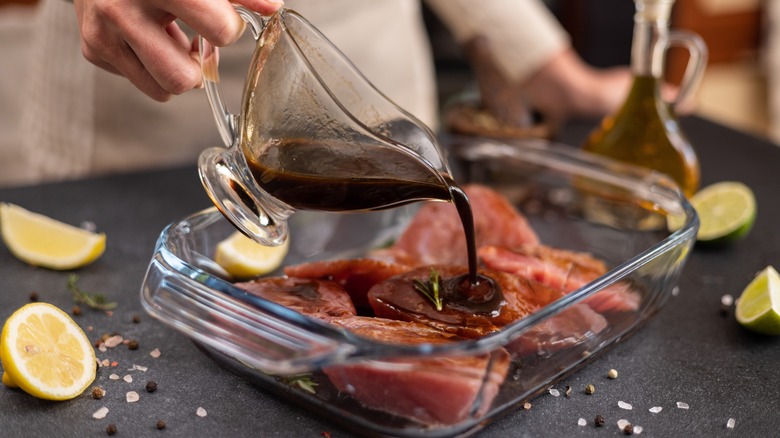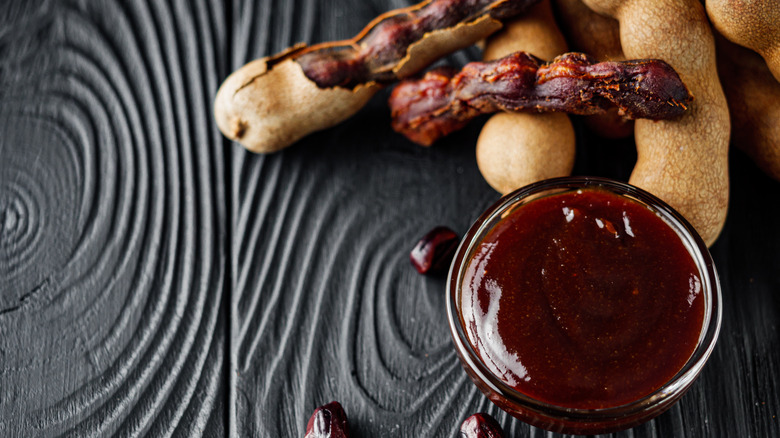The Sweet And Sour Ingredient That Elevates Any Basic Marinade
A good marinade can be a game-changer. It's just a few basic condiments mixed together, yet it holds the power to give any ordinary piece of meat a refined taste and satisfyingly tender texture — when it's done well, that is. A marinade's success comes down to choosing the right ingredients to ensure flavor harmony. Wine or vinegar, an oil, and spices and herbs are a trusty combination that works every time.
Nevertheless, there's always room for trying something new to refresh and excite the palate. Tamarind might be precisely what your marinade needs. What exactly is tamarind? It's a fruit native to Asia and Africa, but don't worry, you can still find it at specialty stores and grocers near you. It usually comes in light brown pods that are solid yet brittle; the insides are soft, pulpy, and fibrous.
As for the flavor, tamarind is as unique as can be. At the first bite, you'll immediately notice its sweet, caramel-like notes. Layered underneath are tangy, tart flavors with a touch of citrus. This interesting and unique mixture allows for quite a lot of culinary usage across cuisines. It can be enjoyed on its own, or used as a flavoring agent for countless dishes, and even drinks.
Making a tamarind marinade
Tamarind's sour, zesty kick and distinctive sweetness is a striking contrast against most marinades' umami-forward flavors. This creates lively complexity that brightens any food it accompanies. There are many ways to harness this unique treat's powers. When it comes to cooking, tamarind in pulp, concentrated, and paste forms are preferable to the raw stuff for their convenience and boldness. You'll often find tamarind pulp in an amber block that requires rehydration with hot water and straining through a sieve. It offers a taste quite similar to fresh tamarind, only more pronounced. A little less authentic are tamarind concentrate and paste, which usually have added preservatives. On the plus side, they're good to go straight out of the package, so the preparation is hassle-free and time-saving.
Keep the tamarind company with other ingredients for an even more multifaceted taste. It could be the gateway to giving your dish an Asian spin with other staples such as soy sauce and fish sauce. A spicy hot sauce, chile paste, or peppery, fragrant garam masala would be ideal for those who adore big flavors. If you want to highlight the sweetness instead, opt for honey, brown sugar, or toasted sesame oil. You can even blend in yogurt for a creamy, tangy twist.
What can you use the tamarind marinade for?
On its own, tamarind is already quite versatile, so you can expect limitless possibilities when it's incorporated into marinades. Chicken — pan-seared, roasted, and especially grilled — is a prime contender. Whether it sits in the marinade for 15 minutes or overnight, flavor-packed, juicy meat is always a guaranteed outcome. You can pair it with a dipping sauce and garnish with scallions or add white rice to fill out the meal.
We can't possibly forget about grilled steak, either. Once marinated and cooked to perfection, the beef becomes lusciously tender and lacquered with this glossy marinade. On the side, all you'd need is a bed of greens or salsa for a restaurant-worthy dish. Sliced into pieces, it makes a great addition to tacos, banh mi, and salads.
A tamarind marinade can also do wonders in brightening the delicate flavor profile of fish. Almost any fish will do, from salmon and tilapia to cod and many others. You can pair it with nuoc cham (a Vietnamese dipping sauce made from fish sauce) for extra brininess, add crispy dried shallots, or sprinkle in lemongrass to enhance the citrus elements.


